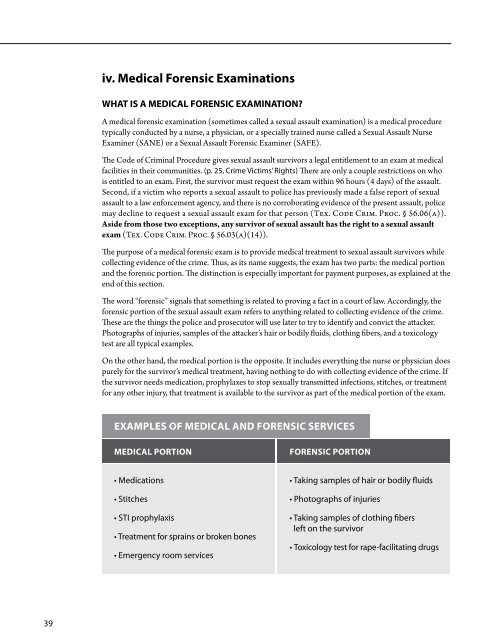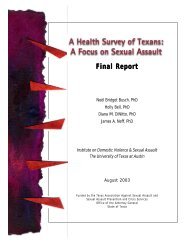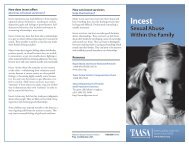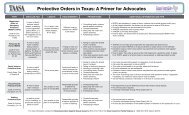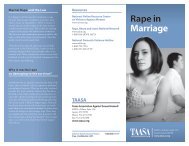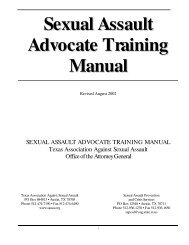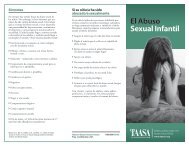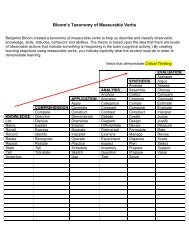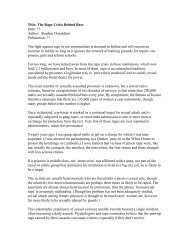Sexual aSSault LEGAL ADVOCACY MANUAL - Texas Association ...
Sexual aSSault LEGAL ADVOCACY MANUAL - Texas Association ...
Sexual aSSault LEGAL ADVOCACY MANUAL - Texas Association ...
You also want an ePaper? Increase the reach of your titles
YUMPU automatically turns print PDFs into web optimized ePapers that Google loves.
iv. Medical Forensic Examinations<br />
What is a Medical Forensic Examination?<br />
A medical forensic examination (sometimes called a sexual assault examination) is a medical procedure<br />
typically conducted by a nurse, a physician, or a specially trained nurse called a <strong>Sexual</strong> Assault Nurse<br />
Examiner (SANE) or a <strong>Sexual</strong> Assault Forensic Examiner (SAFE).<br />
The Code of Criminal Procedure gives sexual assault survivors a legal entitlement to an exam at medical<br />
facilities in their communities. (p. 25, Crime Victims’ Rights) There are only a couple restrictions on who<br />
is entitled to an exam. First, the survivor must request the exam within 96 hours (4 days) of the assault.<br />
Second, if a victim who reports a sexual assault to police has previously made a false report of sexual<br />
assault to a law enforcement agency, and there is no corroborating evidence of the present assault, police<br />
may decline to request a sexual assault exam for that person (Tex. Code Crim. Proc. § 56.06(a)).<br />
Aside from those two exceptions, any survivor of sexual assault has the right to a sexual assault<br />
exam (Tex. Code Crim. Proc. § 56.03(a)(14)).<br />
The purpose of a medical forensic exam is to provide medical treatment to sexual assault survivors while<br />
collecting evidence of the crime. Thus, as its name suggests, the exam has two parts: the medical portion<br />
and the forensic portion. The distinction is especially important for payment purposes, as explained at the<br />
end of this section.<br />
The word “forensic” signals that something is related to proving a fact in a court of law. Accordingly, the<br />
forensic portion of the sexual assault exam refers to anything related to collecting evidence of the crime.<br />
These are the things the police and prosecutor will use later to try to identify and convict the attacker.<br />
Photographs of injuries, samples of the attacker’s hair or bodily fluids, clothing fibers, and a toxicology<br />
test are all typical examples.<br />
On the other hand, the medical portion is the opposite. It includes everything the nurse or physician does<br />
purely for the survivor’s medical treatment, having nothing to do with collecting evidence of the crime. If<br />
the survivor needs medication, prophylaxes to stop sexually transmitted infections, stitches, or treatment<br />
for any other injury, that treatment is available to the survivor as part of the medical portion of the exam.<br />
Examples of Medical and Forensic Services<br />
Medical Portion<br />
Forensic Portion<br />
• Medications<br />
• Stitches<br />
• STI prophylaxis<br />
• Treatment for sprains or broken bones<br />
• Emergency room services<br />
• Taking samples of hair or bodily fluids<br />
• Photographs of injuries<br />
• Taking samples of clothing fibers<br />
left on the survivor<br />
• Toxicology test for rape-facilitating drugs<br />
39


